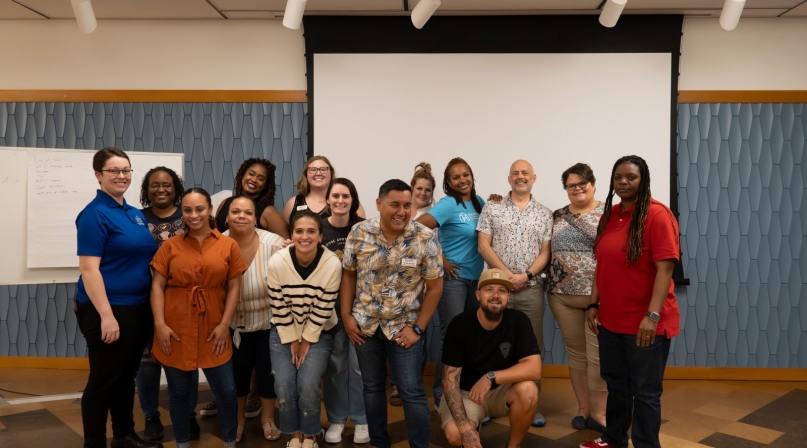Collaboration helps Dallas County, Texas reduce homelessness

Key Takeaways
Dallas County, which has the largest population of people experiencing homelessness in Texas, is working with local governments and non-profits to combat the crisis through the R.E.A.L. Time Rehousing program.
The county has seen results with the program, which launched in October 2021: Chronic homelessness has decreased by 32% and unsheltered homelessness has decreased by 14%.
Non-profit Housing Forward is leading the strategy for and administrating R.E.A.L. Time Rehousing, which has enrolled 3,264 people and placed 1,548 in housing to date. The $72 million initiative, which has administered $2,440,452 in flex funds, is primarily funded through the American Rescue Plan Act.
Along with temporary, and in some cases permanent, housing subsidies, the rapid rehousing program provides supportive services — including mental healthcare, food assistance and job training and placement — acknowledging that housing itself sometimes isn’t enough to keep people out of experiencing homelessness.
“We know that for any of us humans, housing is one component, having a roof over our heads,” said Joli Robinson, president and CEO of Housing Forward. “But we also need support and additional assistance when it comes to finding and navigating maybe the library system, getting connected to health care, job training or certifications … So, for people to be successful, it’s not just about getting them housed, it’s ‘How do we provide those wraparound services and supports so that they can remain housed?’”
The funding allowed for Housing Forward to invest in more case manager positions, making supportive services immediately available to those enrolled; the addition of encampment decommissioning, which engages people living in encampments, connecting them to housing and the creation of a landlord engagement team to find available units with landlords who accept housing vouchers to increase placements.
Each person enrolled in the program goes through an assessment to determine their individual needs and is assigned a case manager.
“They may need a full 12 months of case management, they may need a full 24 months, some may only need six, some may need nine, right?” Robinson said.” So, it’s not a cookie cutter operation — it’s about how are we serving and meeting the needs of an individual?”
The program was formulated out of discussions with Housing Forward, the City of Dallas, Dallas County and the Dallas Housing Authority.
“This model, it allowed us to leverage potentially this one-time tranche of funding, because of COVID that we haven’t seen before and that we may never see again,” Robinson said. “So, it was, ‘How do we work collectively in a way, so that one person doesn’t have one program and then over here have another program, but how do we have a system-wide approach, utilizing and maximizing the dollars and resources, so that we can have direct service providers that are funded in a way so they can provide case management and we can build the landlord engagement team?’
“Because prior to this work, case managers had to go onesies, twosies trying to find landlords to engage. The unique beauty of this process is ‘How do we build a system that really works more effectively and efficiently together to get people housed faster? And to get a large number of people housed?’ So it’s not everybody working in their individual silos, but we’re really working very well together.”
Dallas County Commissioner Theresa Daniel serves as the vice chair of the Dallas Area Partnership to End and Prevent Homelessness Local Government Corporation and also created the Dallas County Housing Work Group, which brought together local governments, nonprofits, developers and shelters to determine how the different groups can best work together to curb the county’s housing crisis.
“If 60% of your income is going toward just rent, that makes it very difficult to actually survive and you’ll get bumped out and end up having to move to … some other place and then figuring out transportation to your job in Dallas County,” Daniel said. “… We’ve been doing PIT (Point-in-Time) counts for eight years, so you could tell where the needs are, but it wasn’t until 2020 when the funding became available that we said, ‘Oh yes, we can do this, with bells on we can do this.’”
About 60% of people experiencing homelessness in Dallas County are Black, a significant over-representation compared to the county’s Black population, which is 23.9%. Roughly 70% of people enrolled in the rapid rehousing program are Black, according to Housing Forward data.
“Racial equity is kind of the centralized tenant of the work that we do in our homeless response system, even outside of this program,” Robinson said. “… It’s not only about the number of people that are enrolled in the program, but we even look at length of time to get people from ‘identified’ to ‘housed’ and are we seeing discrepancies in that?
“…We also say once people hit our system, there’s been a variety of systems that have probably already failed them in a very inequitable way. So, once you hit our system, we are trying our best to ensure that we have equity at the forefront, and that we are really poring over the data in a way that helps us understand, ‘How do we ensure that people are being housed at the same rate? How do we ensure that we’re identifying and engaging and doing appropriate outreach to our population in a way that is equitable as well?’”
The program has 757 vouchers dedicated specifically for domestic violence survivors and families and individuals with chronic health issues.
Daniel pointed to other housing initiatives the county is working on that highlight the fact that homelessness is not a one size-fits-all approach. The initiatives were created specifically for groups who are historically more vulnerable to homelessness, including veterans, the elderly and the LGBTQ+ community.
“It’s kind of interesting, because sometimes I rebel a little bit when we pull all of the main populations apart, thinking that [homelessness] is a problem for all of us, so why are we not addressing it that way?” Daniel said. “Except that it has turned out that it’s more difficult for some groups still to have their needs responded to if they are lumped in with everybody else, which does not seem fair, does not seem right, especially when there is such an awareness of what we’re doing and how we’re doing it.”
R.E.A.L. Time Rehousing is just one of the ways the county is trying to tackle homelessness; other projects in the works include an adoption of Travis County’s Community First! tiny homes village. Dallas County has purchased 75 acres of land for a similar project, and Catholic Charities is renovating a hotel purchased by the county into a 180-unit for supportive housing, according to Dr. Philip Huang, director and health authority for Dallas County’s Health and Human Services department.
“When we’ve been talking to Housing Forward and all the other partners, there are different needs,” Huang said. “It seems like our community is doing better for transitional housing, and so now the biggest need that’s been identified with the Point-in-Time survey and things is the permanent supportive housing.”
The subsidies for R.E.A.L. Time Rehousing will continue through 2024. The program has created necessary infrastructure for future homelessness initiatives, including the community dashboard, which tracks project enrollments, housing placements and racial equity analysis, Robinson said.
“The long-term impact is this has shown us that our system can work very well,” Robinson said. “And so, more than anything, it’s provided a very solid foundation of a changed system for anytime there’s dollars or opportunities to flow into our system.”
Featured Initiative
NACo Housing Task Force
(2022-2023) NACo’s Housing Affordability Task Force examined housing challenges and highlighted county-led solutions to address the housing affordability and inventory crisis. The task force identified intergovernmental and public-private strategies to enhance housing affordability and stability.

Related News

County Countdown – Dec. 15, 2025
Every other week, NACo's County Countdown reviews top federal policy advocacy items with an eye towards counties and the intergovernmental partnership.

